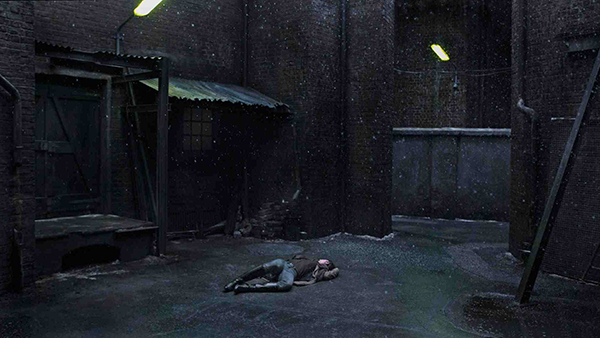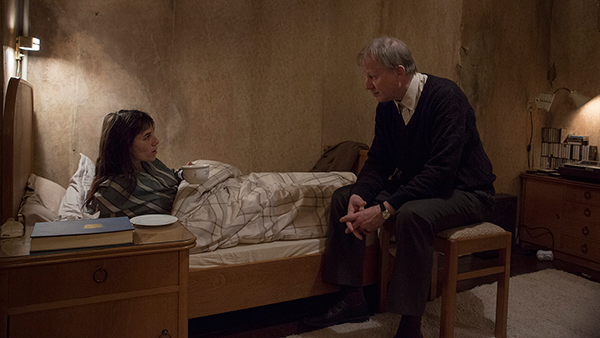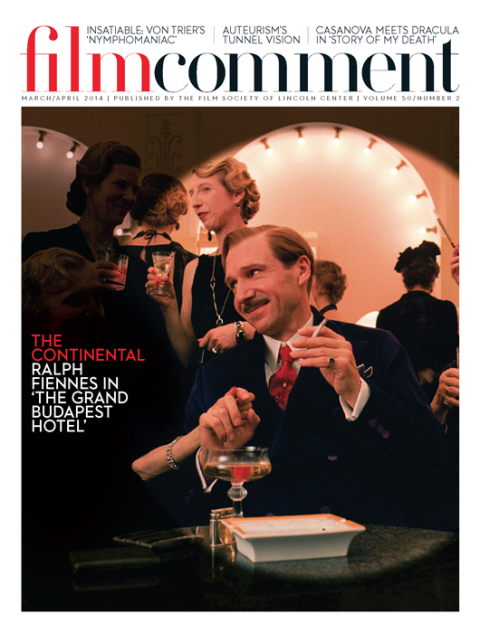There are plenty of filmmakers whose work occupies the love-it-or-loathe-it category, but Lars von Trier is a rarity, in that his work can be loved and loathed simultaneously. You may find yourself relishing his inventiveness and audacity while recoiling from the narcissistic, sometimes bratty knowingness of his will to provoke. Many regard von Trier as simply a controversialist, out to get a rise from critics and audience alike. But there’s no denying he’s a master showman. The unveiling of Nymphomaniac was preceded by several months of teaser extracts on the film’s elegant website, while any temptation to take the film too seriously (or to think that its creator does) was undercut by artwork showing its actors gamely displaying their “orgasm faces.” Meanwhile, von Trier’s refusal to speak publicly since Melancholia (his mouth is taped shut in his latest self-mocking publicity portrait) has further enhanced Nymphomaniac’s mystique.
All this, however, adds to the increasing tendency of von Trier’s films to feel oddly hermetic: whatever the ostensible subjects, each of them seems really to constitute the latest bulletin about what’s on von Trier’s mind, his current state of discomfort with the world or with film language. Nymphomaniac pushes this self-absorbtion to new extremes, and certainly confirms that the director is engaged in a testy dialogue with his detractors; at points, the film resembles those records that rappers devote to venting their spleen at haters of their last release. This is especially evident in a comment made by Seligman (Stellan Skarsgård), a Jewish scholar who remarks early on that anti-Zionism is not the same as anti-Semitism, “despite what certain political powers say”—an aside seemingly aimed at the Cannes Film Festival, which pronounced von Trier persona non grata after he joked about being a Nazi at the Melancholia press conference.
Nymphomaniac is not an easy object to define. It’s one film released as two separate “volumes,” totaling nearly four hours, reduced from an original five-and-a-half (von Trier reputedly approved the shorter cut without actually seeing it). Still other versions will be released internationally, length depending on varying levels of acceptability in different territories. Last month, the Berlin Film Festival premiered the uncut Volume I, running at 145 minutes, as opposed to the theatrically released 117, but the differences were less substantial than expected. There were certainly more male and female genital shots, including close-ups of cunnilingus and surgical insertions during an abortion, while an erect penis that appeared fairly clearly to belong to Shia LaBeouf hoved into view at a number of points. There are, in any case, already plenty of genital close-ups in the short version of the film, although the end credits specify that professional actors did not take part in any penetrative sexual acts; even so, it’s hard to believe that the filmmakers went to the expense of using CGI in all the shots involving LaBeouf. But most of the additional material in the uncut Volume I is simply verbal: notably a speech by Sophie Kennedy Clark’s character B outlining a sexual adventure, and repetitions of Joe’s father’s “ash tree” speech, in what is now a very extended hospital death scene.
Ostensibly the film is about the life of a female sex addict—the preferred term these days, as the heroine’s therapist reminds her, although Joe, played by Charlotte Gainsbourg, militantly reclaims the archaic, misogynistic “nymphomaniac” (you feel that what she’s proudest of is the excess energy contained in “maniac”). The film begins with a battered, bruised Joe found in an alley by Seligman, a solitary, erudite bachelor. He takes Joe to his apartment, offering her tea and shelter, and she tells him her life story, which is from the outset primarily about sex: “I discovered my cunt as a 2-year-old.” Divided into eight chapters with headings, the film unspools as a novelistic picaresque yarn, which Joe seems to improvise prompted by objects found around Seligman’s apartment, Usual Suspects–style.
In this narrative, Joe—played as a younger woman by Stacy Martin—embarks on a tireless sexual odyssey that takes in childhood experiment, loss of virginity, ingenious juggling of multiple partners, sessions with an S&M master, and finally a criminal career as a debt collector, Joe’s intimate knowledge of desire apparently equipping her with the expertise necessary to pressure her victims. The film’s lurid title suggests a throwback to the Seventies, during which Nymphomaniac appears partly to be set, a period associated with a strain of sex cinema that sold itself on the idea of scandalous, excessive female desire: Deep Throat, The Devil in Miss Jones, Insatiable. In fact, the closest Nymphomaniac comes to resembling any actual films about sex is in its parallels with those of Catherine Breillat, who often depicts it as both a potentially transformative ordeal and a passion (in the agonistic sense) to be endured. The close-ups of female genitalia recall Breillat’s Romance and Anatomy of Hell, while a comic interlude in a restaurant (Joe stuffs her vagina with spoons, to the bafflement of the waiter played by Udo Kier) could almost be a tribute to the various insertions of Anatomy and A Real Young Girl.
But you can’t help feeling that sex is somehow not Nymphomaniac’s main concern. It’s as if the film is really about other addictions—to language, narrative, image-making. Von Trier claimed when announcing the film that it would inaugurate a new genre, “Digressionism.” As Joe narrates, Seligman interrupts, objects, offers interpretative commentary, and introduces an array of sometimes incongruous visual footnotes to her story. Joe’s anecdote about her teenage seduction of men on a train prompts Seligman to compare her activity to fly-fishing, as outlined in Izaak Walton’s The Compleat Angler: cue inserts of fishing footage. Later digressions include lessons on botany and church history, and a lengthy analogy between Joe’s lovemaking and the structural makeup of Baroque organ music.
The film rivals Joe’s promiscuity with a visual promiscuity of its own. Its encyclopedic sprawl is lavishly illustrated by DP Manuel Alberto Claro, offering a wider range of cinematic styles than we’ve seen in any previous von Trier film: there are episodes in color and black and white, split screens, overlaid captions, shifts of aspect ratio. There are brief inserts, pasted into the film as if into a scrapbook—fragments of dream imagery, a shot rotated on its side to illustrate that an eye and a vagina are oddly alike depending on your viewpoint, assorted art- and film-historical nods to Balthus, Muybridge, et al. There’s even a knowing (and, I can’t help feeling, cynical) reprise, with a twist, of the kitschy and manipulative slow-motion “prelude” to Melancholia: von Trier’s ultimate nod to his own mythology.

Throughout, the film’s fable-like quality is accentuated by the story’s setting in one of those chimeric quasi-realities that von Trier habitually favors. Joe’s narrative appears to start in Seventies England: cars have British license plates and characters exchange obsolete U.K. banknotes, although the actors speak in an unsettling range of international accents, not always their own (Uma Thurman sounds Scandinavian, Shia LaBeouf seems stranded between East London and Cape Town). As for Seligman’s world, it seems to be a subterranean slum, or a soundstage mock-up of an imaginary Europe, with a Jewish bakery hidden between moldering walls. The studied dilapidation and starkness of Simone Grau’s production design evokes a tawdry, exhausted world in which any sort of spontaneous sensuality is challenged from the outset. It is a world of drab, characterless apartments and functional workspaces; even S&M specialist K (Jamie Bell) occupies an office resembling the premises of a local government department. Sex often appears as a palliative response to the world’s grimness: hence Joe screwing the first orderly she chances on in the hospital where her father (Christian Slater) is dying in agony.
Despite its theme, and its copious graphic content, Nymphomaniac remains austerely unerotic. That’s partly because the sex is scrupulously deglamorized—Stacy Martin’s thin, pale body has the stark vulnerability of a Munch nude, while there’s a comically clinical montage of anonymous flaccid dicks in close-up (the penile equivalent of mug shots). But it’s also because Nymphomaniac is about the demand for sex, as opposed to the possibility of satisfaction. Joe always wants more, the only end to her desire coming not as relief but as interruption at the end of Volume I, when she suddenly announces: “I can’t feel anything.” This, paradoxically, makes her subject to further need—“cauterized” by overstimulation, Joe loses the very urge that defines her and so becomes subject to greater torment, a desire for desire itself (it’s hard not to read this sexual burnout partly as a filmmaker’s analogy for the struggle with artistic exhaustion).
In fact, sex in Nymphomaniac is not primarily without pleasure. Joe, in Volume I at least, finds plenty of satisfaction in sex; the “organ” sequence is entirely about her gratification, and the young Joe is often seen naked and laughing, clearly having a great time. There are more indirect payoffs too, such as her teenage pride in conquering the resistance of the married man she sucks off on a train. But it’s suggested that Joe has few deep, enduring sources of happiness: one is the company of her doomed father, who passes on his love of nature and especially trees; another is a personal breviary in which she presses leaves.

Nymphomaniac reminds us repeatedly and explicitly that things look different depending on the vantage point. In the same way, von Trier has contrived throughout his career simultaneously to appear to be a misogynist and a feminist filmmaker. Do Breaking the Waves (96) and Dogville (03) punish their martyred heroines, or anatomize patriarchy’s victimization of women? Is Antichrist (09) an essay on, or an expression of, male paranoia? Nymphomaniac depicts a decisive woman who makes no apology about being driven by her appetites. The film’s men, conversely, are variously feminized, insipid, or abject; Jerome (LaBeouf) is less an autonomous character than an empty “function” who recurs in different guises throughout Joe’s life. Male weakness and female power are never so strongly highlighted as in the extraordinary, grimly comic scene in which Joe and a bland lover are visited by his abandoned wife, who delivers a thunderously bitter harangue in front of the couple’s children: a devastating tour de force by Thurman. As for the film’s two obviously powerful male figures—the S&M dominator K and Joe’s criminal mentor (Willem Dafoe)—you might well see them as externalized avatars of Joe’s own phallic power.
But in the end, von Trier does seem to be simply punishing another heroine. We finally learn how Joe was brutalized: she has been betrayed by two people she loves, the cruelly ironic price of her compassion. She’s also, at the start, harshly judgmental of herself: “I’m just a bad human being.” After hearing her story, Seligman pleads Joe’s case to her: “You were a human being demanding your right. More than that, you were a woman demanding her right.” And yet the film never seems quite willing to let Joe off the hook. After all, her sexual drive itself becomes the source of her suffering: literally and gruesomely so, when we learn that she has rubbed herself raw by excessive masturbation.
There’s also a curious sidelining of any kind of female community. The teenage Joe forms a secret society of girls devoted to sex without love, but this “Flock” barely figures in this cut of Volume I. We know nothing about her mother (a barely glimpsed Connie Nielsen), except that she was “a cold bitch.” And it’s when Joe takes a teenage outcast (Mia Goth) as her ward and then lover that she finally steps out of her depth: real contact with another woman seals her doom.

Nymphomaniac’s episodic structure offers no shortage of knowing provocations, some more successful than others. There’s a rather clumsily uncomfortable excursus into the realm of sexual tourism—à la Ulrich Seidl’s Paradise: Love—in which Joe is argued over by two African men with dueling erections. Played as farce, the scene is followed by her awkward debate with Seligman on the politics of the word “negro.” More genuinely provocative is the episode in which Joe identifies a covert pedophile (Jean-Marc Barr) and hails him as a kindred “sexual outlaw” and indeed a hero for hiding his desires and never acting on them: a bold take on the “sympathy for the devil” theme explored, in more familiar liberal-melodramatic form, in Nicole Kassell’s The Woodsman.
The film ends, no two ways about it, depressingly. After Joe has played Scheherazade all night, a closing twist suggests that she’s also the Lulu of Pabst’s Pandora’s Box—although unlike Lulu, she seemingly lives to tell her story another day (and, one imagines, another, and another. . .). A life relived in one night has proved to be a season in hell, and a hell from which there’s no escape. Nymphomaniac’s inferno, however, is anything but monotonous: it’s a landscape of unpredictable contradictions and clashes, where pleasure coexists with pain, exuberance with despair, subtle dialectic with heavy overstatement, and even (on the soundtrack) a delicate César Franck violin sonata with hardcore metalists Rammstein bellowing “Nym-pho-maaa-nee-ak!” Nymphomaniac is one von Trier film to which you can’t easily give a thumbs-up—or down—and it’s a dense, labyrinthine undertaking through which you can’t easily find your way. It’s a Dostoevskian sprawl of a creation, at once monstrous and magnificent, infuriating and inspired—von Trier’s most defiant invitation yet to an argument, and an argument, I suspect, that will rage intensely for some time to come.










